FineVu CR-2000S Review: How I Studied a Luxury Recorder with Two Full HD Cameras
Recently, statistics of analysts SmartMarketing came across to me - over the past 2013, sales of registrars in Russia grew by 30%, to almost 1.5 million units. And even if the growth rate declined (a year earlier it was already 80%), domestic motorists still actively acquire “video witnesses”. It’s still far from satiating the market - as of January 1, 2013, there were 50.5 million cars in the country. In my opinion, the majority of motorists buy registrars "once and for all." This is especially sad when the video will really be needed, and the recorder will stop, miss important seconds of shooting, “lock” the file or, due to the extremely poor quality of the shooting, will not allow you to see the vehicle number.

I myself, to some extent, are overly concerned about my own safety in the car, so I intend to scrutinize all the “thematic” novelties and without hesitation I am ready to give a substantial amount for an expensive but really useful device. It is clear that no one wants to pay 10-20 thousand rubles for a registrar without prior testing - how many moments will seem critical shortcomings. Yes, and beautiful marketing words often disagree with the harsh reality. Therefore, I was very pleased to have the opportunity to get acquainted with such a curious product as FineVu CR-2000S.
')
If someone does not know, this model went on sale at the end of last year, but until now it was officially sold only in South Korea - where it is produced. Of course, the "gray" deliveries reached Russia. However, I was not very impressed by the idea of buying an absolutely non-localized device without local service support at all. The situation improved in the first quarter of this year - the Koreans repainted the white body of the registrar in black, added the Russian base of the location of speed cameras, and at the same time attached Russian voice acting and the translation of the menu. The resulting creation was called the editors of the Black Edition and launched for sale in Russia.
Probably, the box could have been made smaller, but for the representative of the “best of the best” category everything should be top notch - even the size of the package. I am impressed by the lack of a nuclear mix on the box of the advantages of the model, although the FineVu CR-2000S is just the case when one could not feel too shy about extolling his product. In general, literally two lines of characteristics and a trio of visual icons - that's the whole “information attack”. Yes, plus a sticker indicating precisely the FineVu CR-2000S version for Russia.
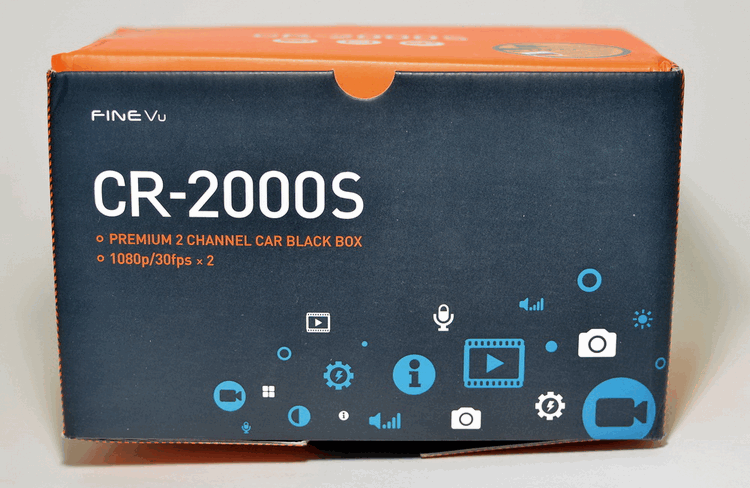

Immediately I will note the only flaw in the configuration. The box did not have a cable for connecting to a computer. You could at least make a card reader. Moreover, the omission of such a cheap accessory does not fit in with a 32 GB microSD memory card neatly folded in a case, and even with an SD adapter. By the way, the registrar basically does not work with cards of less than 16 GB.
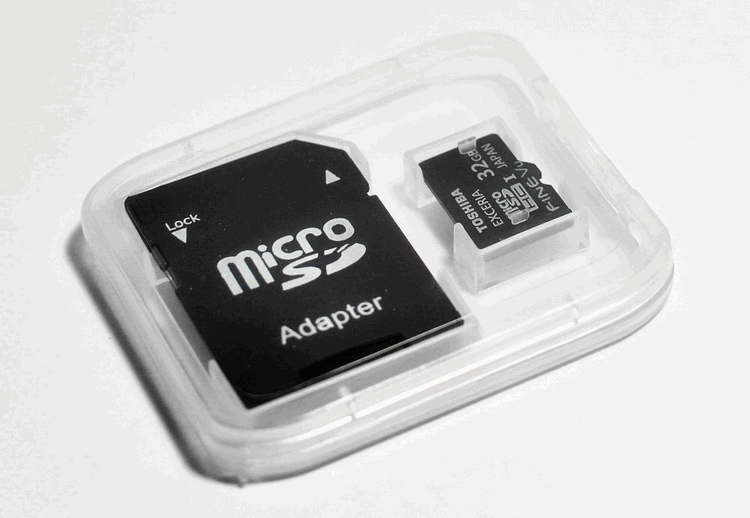
My indignation subsided when I removed an impressive 7-meter cable to connect the rear camera. It even seems to me that FineVu overdid it a bit - I would rather expect to see such strength and length in any device for military equipment.

Until now, I have not seen registrars with an external GPS module present. I am aware of the latest trend, when the receiver is built right into the mount, but then the user does not need to pay attention to it at all. The FineVu CR-2000S in the presence of not just GPS, but a hybrid GPS / GLONASS receiver. Apparently, to improve the signal, we have to deal with another cable, and even think about where to fix the case on the 3M adhesive tape. It is good that in the whole FineVu CR-2000S design this is the only drawback, otherwise the installation and connection of the device left me with positive impressions.
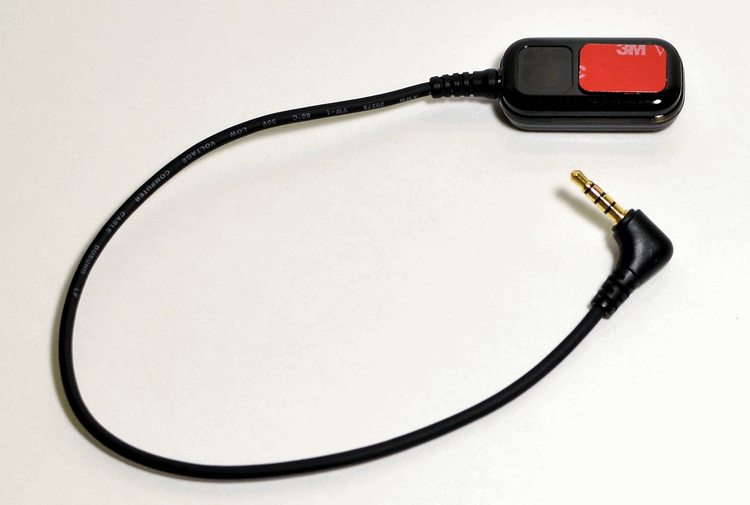
Charger for the cigarette lighter is made with a long cable, it is enough for a hidden gasket from the connector to the recorder. I just in case in store splitters connector. But if I didn’t have them, I wouldn’t have to spend money - a full-fledged USB connector is built into the charging case. So while running FineVu CR-2000S, I periodically recharged my smartphone, which I also use as a navigator.

I did not resort to using complete hooks with stickers, yet I will not have the device, maybe the wire holders will be needed by the future “permanent” owner of the copy. However, the mere presence of hooks plus spare stickers for cameras cannot but rejoice.
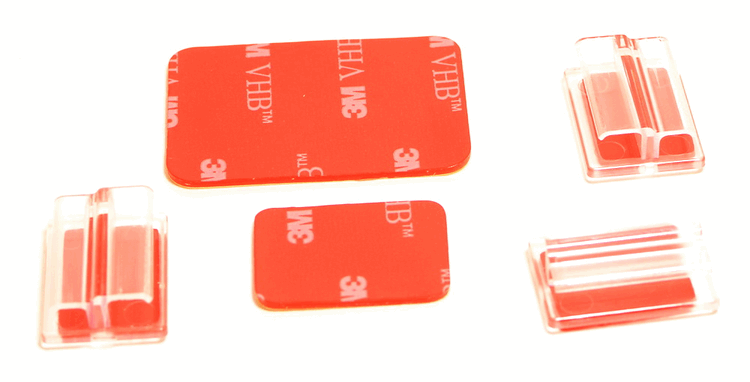
A few words about the instructions. There is practically no continuous monotonous text here, because of which I don’t want to open the user's manual at almost every first registrar at all. In the manual FineVu CR-2000S all the information is framed so that you want to read a book at least once, and the contents in your head are well digested. As far as I know, the package also includes a brand warranty card, so I don’t see a problem in the absence of the address and phone numbers of the service center directly in the manual.
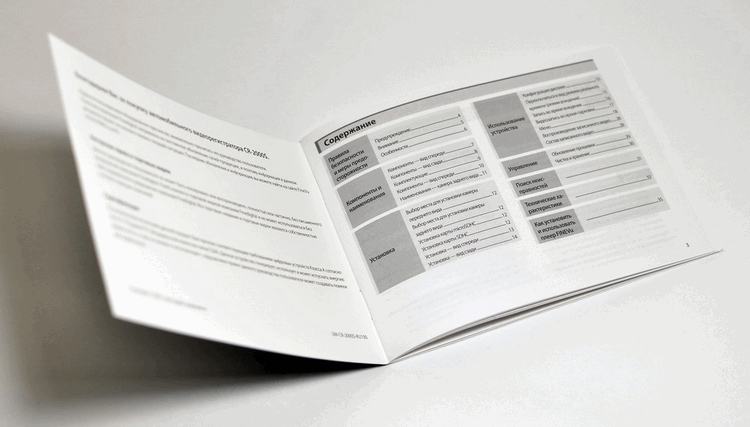
Actually, there are no buttons in FineVu CR-2000S, not one. All management is entirely focused on the touch screen. You thought correctly - even the process of switching on and off will not allow us to manage. It follows from this no less logical conclusion that the recorder “does not exist” outside the machine. The model simply does not have its own battery, only an emergency capacitor for the normal preservation of video in case of problems in the electrical system of the car.
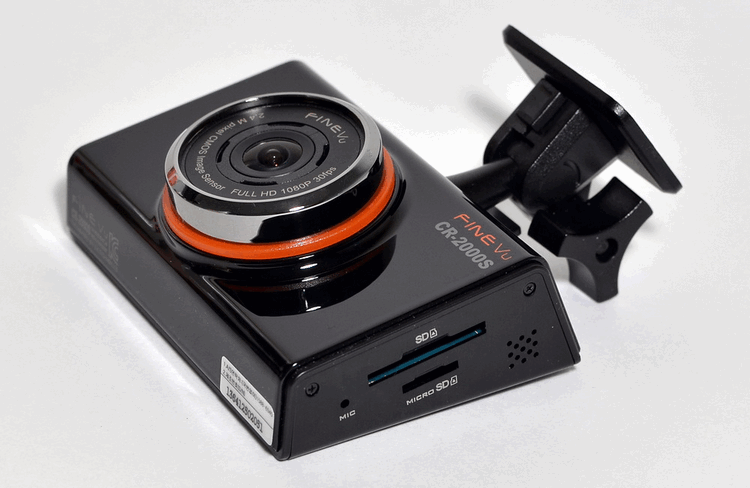
3.5-inch screen - this is a lot for the recorder, it is usually accepted to be limited to a maximum of 3 inches. On the other hand, for a touchscreen display, a small size would completely “kill” all the comfort of use. What struck me about FineVu CR-2000S was the presence of an IPS matrix, and not the more common and cheaper TN-Film. The picture quality and viewing angles are good, I did not expect anything else with such a screen. True, there are claims to sensitivity. Pressing is still better with an effort to eliminate the need for repeated gestures. It is very noticeable that the touch layer is loosely attached to the screen matrix, there is a “gap” of a couple of millimeters. Best of all, the surface responds to touching with a fingernail, which suggests a resistive type of display.

FineVu CR-2000S looks expensive, the model does not take that away. Yes, the weight of the case under 200 grams suggests that inside is not at all budget accessories. However, this is a controversial logic, rather the use of a metal element affected the weight. A single sheet of aluminum is used (if I'm not mistaken), which forms a frame around the display and also covers the sides. The surface of the plate is slightly stylized by horizontal, slightly embossed "fibers". The rest of the surface - the front, top, bottom - covered with gloss. The coating with great eagerness collects fingerprints, but during the tests I didn’t have to take a glossy coating - there was enough metal side panels.
From the front there is nothing but a lens with a “chrome” and an orange ring.

On the left side there is an AV-out and a microUSB connector. Experimentally, I found out that you can use not only the corresponding connector on the top, but also microUSB to power the recorder - so I was able to power the device from an ordinary power outlet and calmly figure out the FineVu CR-2000S menu at home.
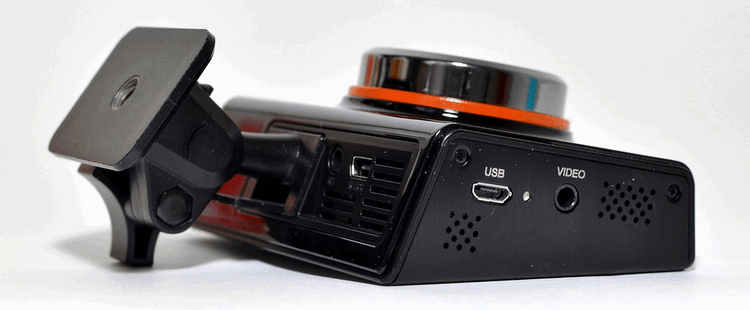
On the right - two whole slots for memory cards, microSD and SD. Immediately, I note that without a microSD card, the recorder will refuse to shoot, and the SD card is necessary to save the video in parking mode. Moreover, you can copy video between memory cards. Before that, I saw the possibility of copying only between internal memory (at best, up to 256 MB) and a card.

Upstairs is a miniUSB connector for connecting a second camera, as well as a power input. This is very convenient, since the cable goes up and does not loom before your eyes, as in recorders with a miniUSB side layout.
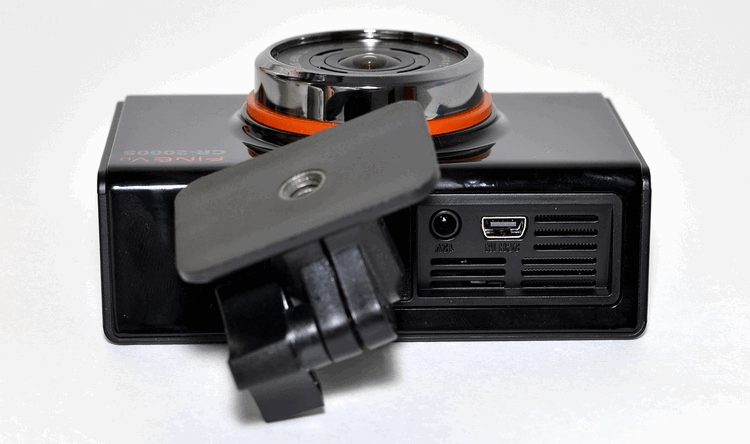
The recorder holder is clicked into the case and quickly removed. The bracket itself has only one hinge, which allows you to somehow adjust the position of the camera. With horror, I remember the recorders, where in the holders for adjustment in each plane was designed its own screw, and the total number of "intermediaries" reached three. Immediately the foot is tiny, the holder does not try to increase the overall dimensions of the design with the recorder. It didn’t manage without one screw, it is designed to clearly fix the selected position. In the recorders are much more common brackets with hinges at all without additional fixation. And it always seems to me that after a couple of years such a hinge will completely lose the rigidity of the stroke and will limply hang out with the camera under glass.
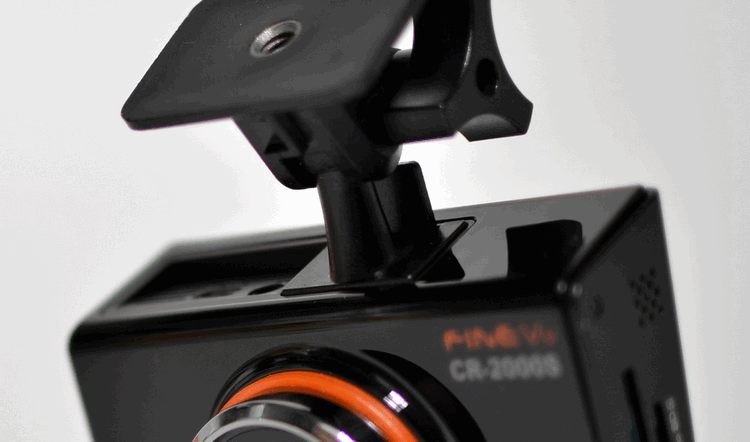
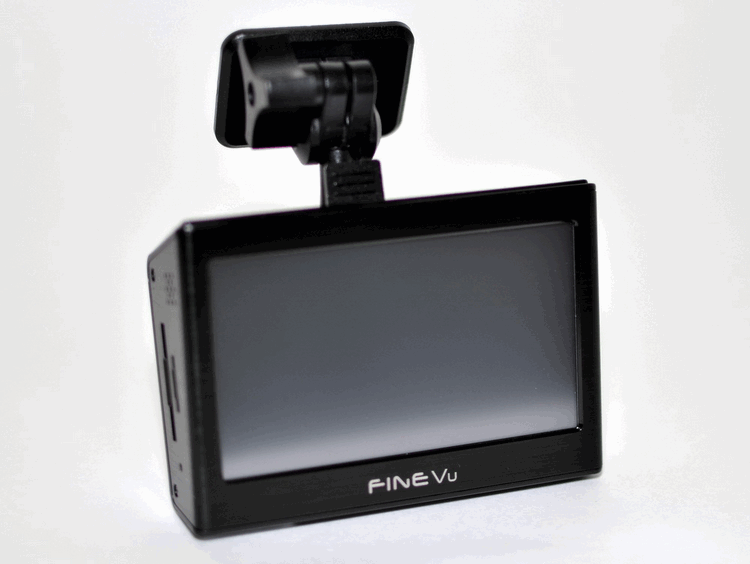
The back of the camera is made in the form of a cube, except for the peephole, on the body there is only a connector for connecting the wires. The mount has a wide angle of deflection, albeit in the same plane.

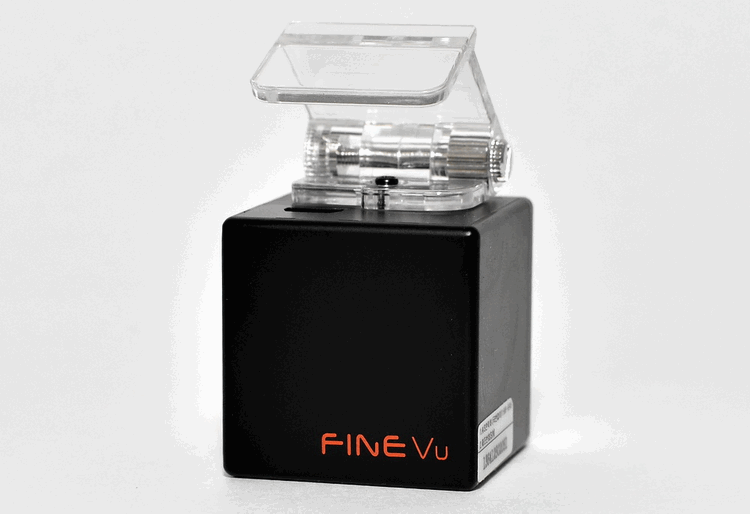
By silence after switching on, a screen is displayed with the transfer of a picture from the camera in real time. At the top left of the recording, the green dot flashes, if the accelerometer triggers, a beep sounds and the color briefly changes to red. By default, there are three buttons below. If you click on the icon with the camera, this will activate recording for up to one minute in a separate “camcoder” folder. In fact, this is something like a manual start of emergency recording with obtaining a file protected from erasing. The icon on the left speaks for itself - turn on and off the microphone. Pressing the central key, go to the settings. If you touch any area except the buttons, then the image from the back camera will open first, then from two in one window, and finally - a display with time, date and distance to the speed camera.

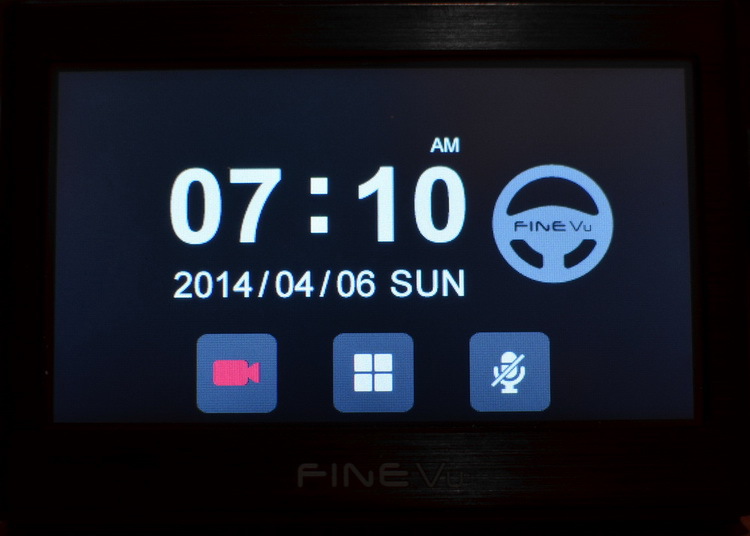
The main feature of the settings is that no matter what item you enter, there will be no scrolling screens. That is, all options fit into one dialog box. And it's great, because I was not at all pleased with the scrolling of endless lists in push-button recorders. The FineVu developers obviously went for reduction of available settings. Although it would be more correct to say this - I did not find some familiar points that the “average” user would still hardly have changed. The interface is five points, it is adapted specifically for touch control, there are no excessively small active elements.

After the first test runs, I noticed that the accelerometer works with too high sensitivity. However, I didn’t manage to detect the G-sensor settings the first time. Who would have thought that the option I needed was hidden in the “Sensitivity / WDR” item. Costs "just in one window," you know. It's funny (in the best sense of the word) the possibility of changing the distribution of memory is made. There are five types of entries in FineVu CR-2000S, which are stored in separate folders on a memory card. By the way, when viewed on the recorder, videos are broken down into tabs according to the type — a very, very convenient solution.
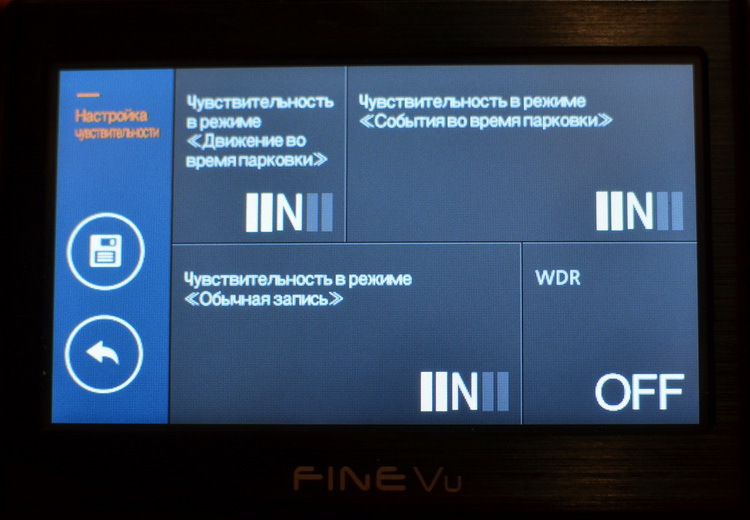
The ability of FineVu CR-2000S to warn about speed cameras is based on a rather commonplace method of setting the “controllers” coordinate base. GLONASS / GPS-receiver monitors the movement of the machine and, as soon as we approach the camera, it warns us. It is not surprising that FineVu CR-2000S can “detect” any stationary complex, including the newest Strelku-ST. I applaud how the storage of the base is organized. The speedcam.txt file is stored in the root directory of the memory card, which is easily editable. Thus, it is possible to update databases without difficulty by means of open projects like mapcam.info. Actually, I did, and therefore I will not say anything special about the accuracy of the warnings. According to the latest data from the same mapcam.info, my FineVu CR-2000S was able to warn about 400,000 objects.
A few words should be said about the receiver. The use of GLONASS / GPS in the recorder, without the navigation option, does not seem to me justified. Yes, the stability and accuracy of receiving signals is higher compared to conventional GPS. However, even in a device like the FineVu CR-2000S, this does not give special advantages. However, if we are dealing with a top registrar, then everything should be at the highest level, including a satellite receiver.
Ambarella A7 is becoming such a widespread processor in recorders that I didn’t expect any other “heart” from FineVu CR-2000S. Despite the fact that I am familiar with the characteristics of the Ambarella A7LS family, support for dual recording in Full HD has become a discovery for me. However, who else but this processor with its 700 MHz frequency is responsible for the frankly not weak load of two-channel shooting. After the first couple of days of use, I realized that the metal and numerous vents in the FineVu CR-2000S are not accidental. The body heats up, and otherwise we would observe regular failures at work. Fortunately, FineVu CR-2000S functioned steadily, and withstand even dignity for approximately two hours.

I can not say much about the Sony Exmor 2.4-megapixel matrix - as far as I remember, in the top segment of recorders it appeared recently and properly contributes to high-quality shooting. By the way, the same matrix is installed in the rear chamber. For comparison, in the former leader of dual channel recorders - BlackVue DR550GW-2CH - only 1 MP Sony Exmor matrix, which writes not in Full HD, but only in HD, is responsible for back shooting. According to the lens, I did not find official data, but in numerous news publications there are six-lens optics with coated glasses. Thus, in cloudy weather and at night, the picture should not roll down to the “porridge” of dark pixels.
Before turning to the assessment of shooting results, I’ll tell you a little more about video modes and shooting features. The recorder immediately turns on and starts shooting when the car's engine is running. If the rear camera is not connected, first of all, we get a warning about this. A pleasant female voice reports “Video is in progress” - let's go. A choice of resolution options are available: HD, HD + (1600 x 900 pixels) and Full HD. I did not understand why there is a “square” with a frame rate in the menu for the front camera, because it does not change at all and varies between 15/30 FPS only for the rear camera. For each camera, you can adjust the sharpness, brightness (worth considering during the day) and brightness at night. The recorder supports WDR (Wide Dynamic Range), thanks to which it copes well with “highlighting” pictures at night in areas with no roadside lighting. The recorder has two types of parking. The first is triggering on motion in the frame. The second one is unusual, the detection of accelerometer signals, I hadn’t seen anything like this before.
By and large, I have a complaint only about splitting files when writing - intervals of two minutes do not seem optimal to me. And all the more it is incomprehensible to me what FineVu's experts were guided by, completely forbidding to change this interval or even to make a record without splitting into fragments.
Original file
Original file
I liked the resulting video samples. I will not say that this is the ultimate quality - the registrars always have and will continue to grow, but in fact I don’t even have much to describe. WDR helps cameras cope with contrasting scenes when the sun is shining directly into the camera, the color rendering is excellent, and this is especially noticeable at night. I would like to see a better distance of readability of numbers, but so far, in principle, I have not met recorders with a distinctiveness of more than 10-15 meters. I advise you not to be shy to experiment with additional settings, for example, on cloudy days I set the sharpness and brightness one division higher than the “norm”.
With a video from the back of the camera came a small technical overlay, so I will provide a couple of examples only for evening and night recording.
Original file
Original file
At the moment, FineVu CR-2000S has no direct competitors, if we start from the support of dual-channel shooting in Full HD. You can call a couple of models approximate in their abilities, but they are still not equal rivals. The only question is, how highly would you rate the benefits of FineVu CR-2000S and decide whether to pay almost 20 thousand rubles for the model. Personally, I don’t see anything supernatural in such a price tag, because the registrars are also represented in the market for 12-14 thousand rubles, and even single-channel ones.
In the minuses of FineVu CR-2000S, I will write down the external GPS module, the lack of a battery, and not everyone will like the too simplified interface and settings. Configuration clearly does not interfere with the cable for connecting to a computer. The last point - it is obvious that the dimensions of the FineVu CR-2000S are not talking about a hidden installation. In this case, it would not be superfluous to supplement the front side with a diode burning during the shooting. Since the recording process cannot be hidden, it is better to consciously pay attention to it - so the traffic police officer will behave more correctly before the start of communication, and the hot-tempered owners of other cars will surely stop their ardor.
Pluses have FineVu CR-2000S much more. Well-thought-out management, which people who do not particularly “rummage” in this technique will appreciate. , , , . YouTube, , «» . , FineVu CR-2000S , .

I myself, to some extent, are overly concerned about my own safety in the car, so I intend to scrutinize all the “thematic” novelties and without hesitation I am ready to give a substantial amount for an expensive but really useful device. It is clear that no one wants to pay 10-20 thousand rubles for a registrar without prior testing - how many moments will seem critical shortcomings. Yes, and beautiful marketing words often disagree with the harsh reality. Therefore, I was very pleased to have the opportunity to get acquainted with such a curious product as FineVu CR-2000S.
')
If someone does not know, this model went on sale at the end of last year, but until now it was officially sold only in South Korea - where it is produced. Of course, the "gray" deliveries reached Russia. However, I was not very impressed by the idea of buying an absolutely non-localized device without local service support at all. The situation improved in the first quarter of this year - the Koreans repainted the white body of the registrar in black, added the Russian base of the location of speed cameras, and at the same time attached Russian voice acting and the translation of the menu. The resulting creation was called the editors of the Black Edition and launched for sale in Russia.
Equipment
Probably, the box could have been made smaller, but for the representative of the “best of the best” category everything should be top notch - even the size of the package. I am impressed by the lack of a nuclear mix on the box of the advantages of the model, although the FineVu CR-2000S is just the case when one could not feel too shy about extolling his product. In general, literally two lines of characteristics and a trio of visual icons - that's the whole “information attack”. Yes, plus a sticker indicating precisely the FineVu CR-2000S version for Russia.


Immediately I will note the only flaw in the configuration. The box did not have a cable for connecting to a computer. You could at least make a card reader. Moreover, the omission of such a cheap accessory does not fit in with a 32 GB microSD memory card neatly folded in a case, and even with an SD adapter. By the way, the registrar basically does not work with cards of less than 16 GB.

My indignation subsided when I removed an impressive 7-meter cable to connect the rear camera. It even seems to me that FineVu overdid it a bit - I would rather expect to see such strength and length in any device for military equipment.

Until now, I have not seen registrars with an external GPS module present. I am aware of the latest trend, when the receiver is built right into the mount, but then the user does not need to pay attention to it at all. The FineVu CR-2000S in the presence of not just GPS, but a hybrid GPS / GLONASS receiver. Apparently, to improve the signal, we have to deal with another cable, and even think about where to fix the case on the 3M adhesive tape. It is good that in the whole FineVu CR-2000S design this is the only drawback, otherwise the installation and connection of the device left me with positive impressions.

Charger for the cigarette lighter is made with a long cable, it is enough for a hidden gasket from the connector to the recorder. I just in case in store splitters connector. But if I didn’t have them, I wouldn’t have to spend money - a full-fledged USB connector is built into the charging case. So while running FineVu CR-2000S, I periodically recharged my smartphone, which I also use as a navigator.

I did not resort to using complete hooks with stickers, yet I will not have the device, maybe the wire holders will be needed by the future “permanent” owner of the copy. However, the mere presence of hooks plus spare stickers for cameras cannot but rejoice.

A few words about the instructions. There is practically no continuous monotonous text here, because of which I don’t want to open the user's manual at almost every first registrar at all. In the manual FineVu CR-2000S all the information is framed so that you want to read a book at least once, and the contents in your head are well digested. As far as I know, the package also includes a brand warranty card, so I don’t see a problem in the absence of the address and phone numbers of the service center directly in the manual.

Appearance, connectors and buttons
Actually, there are no buttons in FineVu CR-2000S, not one. All management is entirely focused on the touch screen. You thought correctly - even the process of switching on and off will not allow us to manage. It follows from this no less logical conclusion that the recorder “does not exist” outside the machine. The model simply does not have its own battery, only an emergency capacitor for the normal preservation of video in case of problems in the electrical system of the car.

3.5-inch screen - this is a lot for the recorder, it is usually accepted to be limited to a maximum of 3 inches. On the other hand, for a touchscreen display, a small size would completely “kill” all the comfort of use. What struck me about FineVu CR-2000S was the presence of an IPS matrix, and not the more common and cheaper TN-Film. The picture quality and viewing angles are good, I did not expect anything else with such a screen. True, there are claims to sensitivity. Pressing is still better with an effort to eliminate the need for repeated gestures. It is very noticeable that the touch layer is loosely attached to the screen matrix, there is a “gap” of a couple of millimeters. Best of all, the surface responds to touching with a fingernail, which suggests a resistive type of display.

FineVu CR-2000S looks expensive, the model does not take that away. Yes, the weight of the case under 200 grams suggests that inside is not at all budget accessories. However, this is a controversial logic, rather the use of a metal element affected the weight. A single sheet of aluminum is used (if I'm not mistaken), which forms a frame around the display and also covers the sides. The surface of the plate is slightly stylized by horizontal, slightly embossed "fibers". The rest of the surface - the front, top, bottom - covered with gloss. The coating with great eagerness collects fingerprints, but during the tests I didn’t have to take a glossy coating - there was enough metal side panels.
From the front there is nothing but a lens with a “chrome” and an orange ring.

On the left side there is an AV-out and a microUSB connector. Experimentally, I found out that you can use not only the corresponding connector on the top, but also microUSB to power the recorder - so I was able to power the device from an ordinary power outlet and calmly figure out the FineVu CR-2000S menu at home.

On the right - two whole slots for memory cards, microSD and SD. Immediately, I note that without a microSD card, the recorder will refuse to shoot, and the SD card is necessary to save the video in parking mode. Moreover, you can copy video between memory cards. Before that, I saw the possibility of copying only between internal memory (at best, up to 256 MB) and a card.

Upstairs is a miniUSB connector for connecting a second camera, as well as a power input. This is very convenient, since the cable goes up and does not loom before your eyes, as in recorders with a miniUSB side layout.

The recorder holder is clicked into the case and quickly removed. The bracket itself has only one hinge, which allows you to somehow adjust the position of the camera. With horror, I remember the recorders, where in the holders for adjustment in each plane was designed its own screw, and the total number of "intermediaries" reached three. Immediately the foot is tiny, the holder does not try to increase the overall dimensions of the design with the recorder. It didn’t manage without one screw, it is designed to clearly fix the selected position. In the recorders are much more common brackets with hinges at all without additional fixation. And it always seems to me that after a couple of years such a hinge will completely lose the rigidity of the stroke and will limply hang out with the camera under glass.


The back of the camera is made in the form of a cube, except for the peephole, on the body there is only a connector for connecting the wires. The mount has a wide angle of deflection, albeit in the same plane.


In work
By silence after switching on, a screen is displayed with the transfer of a picture from the camera in real time. At the top left of the recording, the green dot flashes, if the accelerometer triggers, a beep sounds and the color briefly changes to red. By default, there are three buttons below. If you click on the icon with the camera, this will activate recording for up to one minute in a separate “camcoder” folder. In fact, this is something like a manual start of emergency recording with obtaining a file protected from erasing. The icon on the left speaks for itself - turn on and off the microphone. Pressing the central key, go to the settings. If you touch any area except the buttons, then the image from the back camera will open first, then from two in one window, and finally - a display with time, date and distance to the speed camera.


The main feature of the settings is that no matter what item you enter, there will be no scrolling screens. That is, all options fit into one dialog box. And it's great, because I was not at all pleased with the scrolling of endless lists in push-button recorders. The FineVu developers obviously went for reduction of available settings. Although it would be more correct to say this - I did not find some familiar points that the “average” user would still hardly have changed. The interface is five points, it is adapted specifically for touch control, there are no excessively small active elements.

After the first test runs, I noticed that the accelerometer works with too high sensitivity. However, I didn’t manage to detect the G-sensor settings the first time. Who would have thought that the option I needed was hidden in the “Sensitivity / WDR” item. Costs "just in one window," you know. It's funny (in the best sense of the word) the possibility of changing the distribution of memory is made. There are five types of entries in FineVu CR-2000S, which are stored in separate folders on a memory card. By the way, when viewed on the recorder, videos are broken down into tabs according to the type — a very, very convenient solution.

The ability of FineVu CR-2000S to warn about speed cameras is based on a rather commonplace method of setting the “controllers” coordinate base. GLONASS / GPS-receiver monitors the movement of the machine and, as soon as we approach the camera, it warns us. It is not surprising that FineVu CR-2000S can “detect” any stationary complex, including the newest Strelku-ST. I applaud how the storage of the base is organized. The speedcam.txt file is stored in the root directory of the memory card, which is easily editable. Thus, it is possible to update databases without difficulty by means of open projects like mapcam.info. Actually, I did, and therefore I will not say anything special about the accuracy of the warnings. According to the latest data from the same mapcam.info, my FineVu CR-2000S was able to warn about 400,000 objects.
A few words should be said about the receiver. The use of GLONASS / GPS in the recorder, without the navigation option, does not seem to me justified. Yes, the stability and accuracy of receiving signals is higher compared to conventional GPS. However, even in a device like the FineVu CR-2000S, this does not give special advantages. However, if we are dealing with a top registrar, then everything should be at the highest level, including a satellite receiver.
Video
Ambarella A7 is becoming such a widespread processor in recorders that I didn’t expect any other “heart” from FineVu CR-2000S. Despite the fact that I am familiar with the characteristics of the Ambarella A7LS family, support for dual recording in Full HD has become a discovery for me. However, who else but this processor with its 700 MHz frequency is responsible for the frankly not weak load of two-channel shooting. After the first couple of days of use, I realized that the metal and numerous vents in the FineVu CR-2000S are not accidental. The body heats up, and otherwise we would observe regular failures at work. Fortunately, FineVu CR-2000S functioned steadily, and withstand even dignity for approximately two hours.

I can not say much about the Sony Exmor 2.4-megapixel matrix - as far as I remember, in the top segment of recorders it appeared recently and properly contributes to high-quality shooting. By the way, the same matrix is installed in the rear chamber. For comparison, in the former leader of dual channel recorders - BlackVue DR550GW-2CH - only 1 MP Sony Exmor matrix, which writes not in Full HD, but only in HD, is responsible for back shooting. According to the lens, I did not find official data, but in numerous news publications there are six-lens optics with coated glasses. Thus, in cloudy weather and at night, the picture should not roll down to the “porridge” of dark pixels.
Before turning to the assessment of shooting results, I’ll tell you a little more about video modes and shooting features. The recorder immediately turns on and starts shooting when the car's engine is running. If the rear camera is not connected, first of all, we get a warning about this. A pleasant female voice reports “Video is in progress” - let's go. A choice of resolution options are available: HD, HD + (1600 x 900 pixels) and Full HD. I did not understand why there is a “square” with a frame rate in the menu for the front camera, because it does not change at all and varies between 15/30 FPS only for the rear camera. For each camera, you can adjust the sharpness, brightness (worth considering during the day) and brightness at night. The recorder supports WDR (Wide Dynamic Range), thanks to which it copes well with “highlighting” pictures at night in areas with no roadside lighting. The recorder has two types of parking. The first is triggering on motion in the frame. The second one is unusual, the detection of accelerometer signals, I hadn’t seen anything like this before.
By and large, I have a complaint only about splitting files when writing - intervals of two minutes do not seem optimal to me. And all the more it is incomprehensible to me what FineVu's experts were guided by, completely forbidding to change this interval or even to make a record without splitting into fragments.
Original file
Original file
I liked the resulting video samples. I will not say that this is the ultimate quality - the registrars always have and will continue to grow, but in fact I don’t even have much to describe. WDR helps cameras cope with contrasting scenes when the sun is shining directly into the camera, the color rendering is excellent, and this is especially noticeable at night. I would like to see a better distance of readability of numbers, but so far, in principle, I have not met recorders with a distinctiveness of more than 10-15 meters. I advise you not to be shy to experiment with additional settings, for example, on cloudy days I set the sharpness and brightness one division higher than the “norm”.
With a video from the back of the camera came a small technical overlay, so I will provide a couple of examples only for evening and night recording.
Original file
Original file
Conclusion
At the moment, FineVu CR-2000S has no direct competitors, if we start from the support of dual-channel shooting in Full HD. You can call a couple of models approximate in their abilities, but they are still not equal rivals. The only question is, how highly would you rate the benefits of FineVu CR-2000S and decide whether to pay almost 20 thousand rubles for the model. Personally, I don’t see anything supernatural in such a price tag, because the registrars are also represented in the market for 12-14 thousand rubles, and even single-channel ones.
In the minuses of FineVu CR-2000S, I will write down the external GPS module, the lack of a battery, and not everyone will like the too simplified interface and settings. Configuration clearly does not interfere with the cable for connecting to a computer. The last point - it is obvious that the dimensions of the FineVu CR-2000S are not talking about a hidden installation. In this case, it would not be superfluous to supplement the front side with a diode burning during the shooting. Since the recording process cannot be hidden, it is better to consciously pay attention to it - so the traffic police officer will behave more correctly before the start of communication, and the hot-tempered owners of other cars will surely stop their ardor.
Pluses have FineVu CR-2000S much more. Well-thought-out management, which people who do not particularly “rummage” in this technique will appreciate. , , , . YouTube, , «» . , FineVu CR-2000S , .
Source: https://habr.com/ru/post/220809/
All Articles